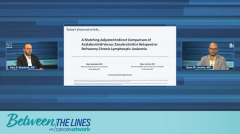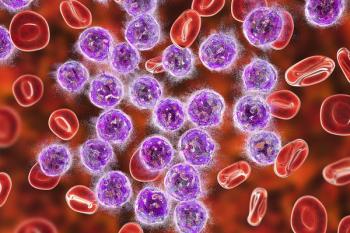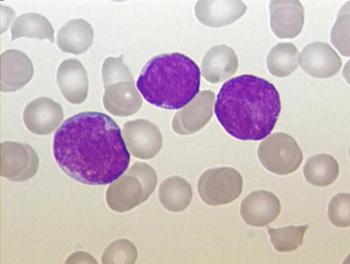
Indirect Comparison of Acalabrutinib Versus Zanubrutinib in RR CLL: Efficacy Analysis
Alan Skarbnik, MD, and Ryan Jacobs, MD, review efficacy data from the indirect comparison study of acalabrutinib versus zanubrutinib in relapsed/refractory chronic lymphocytic leukemia.
Episodes in this series

Transcript:
Alan P. Skarbnik, MD: It is an unanchored matching-adjusted indirect comparison or MAIC. This was a study designed to minimize differences between those patients' populations and we identified variables for matching that would be prognostic or predictive, including age, regional enrollment, sex, bulky disease, IGHV status, presence or absence of deletion 17p, 11q, TP53 mutations with or without deletion 17p, Rai stage, performance status, prior chemo, [and the] number of prior lines of therapy. We did have an individual patient that [was] allowed from the ASCEND study. There were 155 patients in the acalabrutinib arm there, and we weighted variables to match aggregate data from the ALPINE trial, from the publication with 327 patients. Here is an overview of both studies. The ASCEND trial where patients with relapsed/refractory CLL, with at least one prior systemic therapy, decent performance status, true or less, adequate hematologic, hepatic, and renal function, and patients with significant cardiovascular disease previously treated with a BTKi PI3 kinase inhibitor, Syk inhibitor, BCL-2 inhibitor were excluded.
Those patients took 100 mg twice a day of acalabrutinib until disease progression or inaccessible toxicity versus investigator’s choice of either idelalisib with rituximab or bendamustine plus rituximab [BR]. BR was for 6 cycles, idelalisib with rituximab was until progression. ALPINE trial with a similar patient population relapsed/refractory CLL/SLL [small lymphocytic lymphoma], at least from prior systemic therapy, performance status of ECOG 2 or less, adequate bone marrow and organ function excluded with bleeding disorders, active infections, intracranial hemorrhage, recent prior malignancy, or major surgery. Zanubrutinib was given 160 mg twice a day and it was randomized versus ibrutinib 420 mg once daily, both until progression acceptable toxicity. The extra individual patient data from ASCEND and the published aggregated data from ALPINE and the efficacy endpoint we're looking at was investigator assessed PFS [progression-free survival] between those two agents and pseudo individual patient data [IPD] for zanubrutinib investigator PFS, which were obtained via the published Kaplan-Meier curves and safety and endpoints were odd ratios of adverse events. To equalize those studies again, because ASCEND had a much longer follow up at this point than ALPINE [NCT03734016], we established the median follow up as 28.4 months, which was a median follow up for ALPINE, and we officially did a cutoff date in ASCEND [NCT00135226] at 28.4 months, because a number of those side effects accumulate over time.
Ryan W. Jacobs, MD: Alan, I know with ALPINE coming later, a question might come up. Were patients on that relapsed population- had they received treatments like venetoclax?
Alan P. Skarbnik, MD: They were not excluded from the study, but it was not the majority of the population. It was a minor frequency in that study, but that's an important question. Here are the key baseline characteristics. Acalabrutinib pre-matching was 155 patients and post-matching it dropped to 99 patients, to be a comparable population to zanubrutinib, which is 327 patients. So here, it was amplifying that the differences between pre- and post-matching were not that big. Age didn't change that much, it performed the status, male from 70 to 65%. You can see on the 2 curved- the middle column and the right column, that those factors are fairly similar between the two studies. Looking here at deletion 17p, 14% in both studies post-matching, 11q, 28% in both studies, TP53, overall 20%, and it was not reported overall.
In zanubrutinib, it was with or without deletion 17p, so we get the aggregate number there, but those numbers are very similar between each other. 9% in both. 23% in both. Mutated IGHV [immunoglobulin heavy-chain variable] was 24% in both after matching. Again, these populations became much more uniform for comparison. The primary efficacy analysis was using acalabrutinib and zanubrutinib, and using the matching, again. The number dropped from 155 to 99. Here, the investigator assessed PFS at 12 and 24 months for each of the studies. At 12 months pre-matching for acalabrutinib was 89%, post-matching was 91%. Again, not a lot of difference there and for zanubrutinib it was 92%, and the 24 months was 75, 76 and 78%. So, comparing acalabrutinib, even pre-matching, but post-matching where we were trying to get a more uniform population here, they overlapped. The hazard ratio was 0.9, but they crossed one boundary, so not statistically significant. Those curves were on top of each other.
Ryan W. Jacobs, MD: It looks pretty similar.
Alan P. Skarbnik, MD: Correct. The efficacy looks pretty similar on those studies. The secondary efficacy analysis compared acalabrutinib, individual-level patient data with aggregate ibrutinib data from ALPINE, from the same study. Using that, acalabrutinib demonstrated superior investigator PFS to ibrutinib with a hazard ratio of 0.6 with statistical significance there. That would be the expectation given that it matched the zanubrutinib efficacy there, and in that trial with the direct comparisons, and zanubrutinib performed better than ibrutinib. There was a question that we had, because in the ELEVATE-RR [study] [NCT02477696] with a high-risk population, both drugs had the same efficacy. They overlapped, the hazard ratio was exactly 1, and it had a long-term follow up. For sensitivity analysis, we included pooled acalabrutinib individual patient-level data from ASCEND and ELEVATE-RR, so a larger number. It matches zanubrutinib better from ALPINE and the pooled acalabrutinib/zanubrutinib arm, there was no difference in investigator-assessed PFS as well, hazard ratio was 0.92. So, again, possibly showing that these drugs may have similar efficacy.
Ryan W. Jacobs, MD: When acalabrutinib was compared to the same ibrutinib patients that zanubrutinib was in ALPINE, it looks like they both showed a PFS benefit.
Alan P. Skarbnik, MD: Correct. Again, we have to take into consideration the indirect comparison analysis. But yes, that's what it showed. Here is the Kaplan-Meier curve showing exactly what you just commented. The two curves on the top, zanubrutinib and acalabrutinib, the purple and the blue curve, showing a difference in PFS there, in comparison to ibrutinib. Here are the 12-month investigator PFS for all 3 agents. 91% for acalabrutinib, 92% for zanubrutinib, 84% for ibrutinib. And the 24 months, 76% for acalabrutinib, 78% for zanubrutinib, and 66% for ibrutinib. Yes, we could see a separation occurring there when comparing to that more diverse patient population than ELEVATE-RR.
Transcript edited for clarity.
Newsletter
Stay up to date on recent advances in the multidisciplinary approach to cancer.























































































